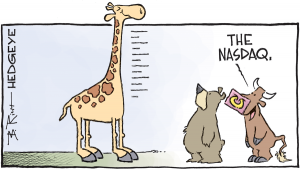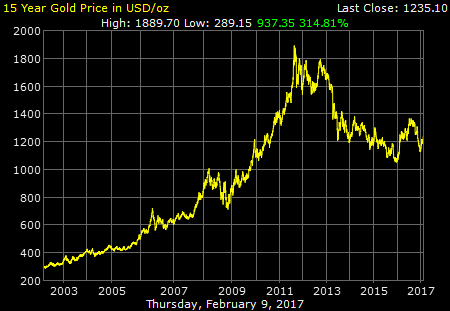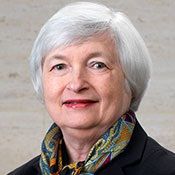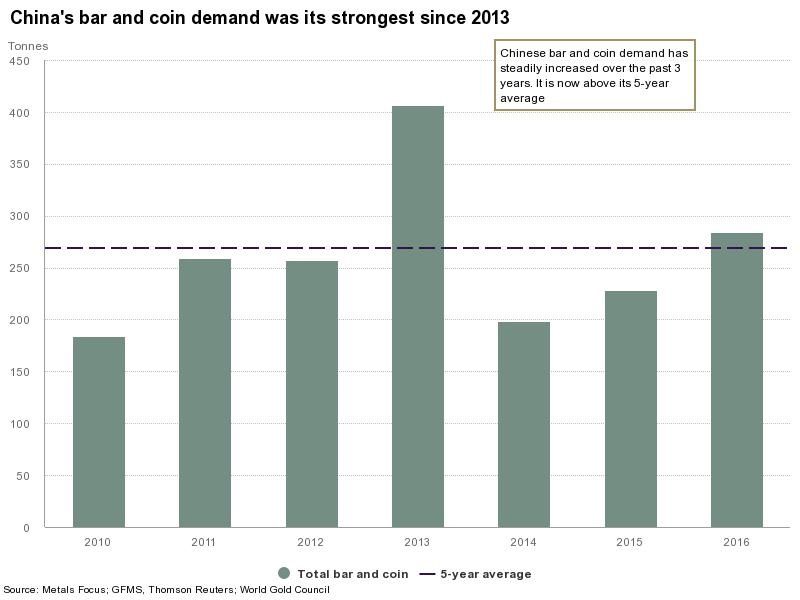Stocks Surpass Records, Again
Posted on — Leave a commentUS equity markets extended gains for a third consecutive day on Friday as they continued to climb and make new all-time highs. The Nasdaq 100 composite index closed in positive territory every single day of the last seven consecutive trading days, while the Dow and S&P 500 have experienced a vigorous three-day-long rally.

The recent, and by some people’s definition, extended, rally in US stocks has created somewhat of a division among bulls and bears as to where the market will go from here.
Omar Aguilar, the chief investment officer of equities at Charles Schwab with over $2.5 trillion in client assets noted how “we’re really seeing a bifurcation in views about the market, but that’s healthy. When some people are too optimistic and others are too pessimistic, it ends up that fundamentals wind up as the driver.”
There’s certainly no shortage of bullish fundamental information to keep pushing stocks past record levels. For the first time in six fiscal quarters, corporate earnings, as a whole, have been positive and the labor market is enjoying its longest-ever streak of job creation – ever. Moreover, there is chatter of increased fiscal spending and tax reductions for corporations, which would stimulate the economy and increase the bottom line of companies, respectively.
Omar also noted how markets could likely maintain their current trading action well into the first half of 2017. “If stocks took a leg higher we’d see people selling and taking profits, and if stocks fell you’d see people seeking opportunities and buying in,” he said.
Ultimately, stocks are showing a lot of strength, yet they are still underperforming precious metals. Gold and silver both recovered from a sell-off on Thursday and finished positive for the week. For the year, gold is up 6.74% and silver is up 12.08%, compared with just 3.5% for the S&P 500.
Analysts interpret the fact that gold market keeps moving north and recovering from sell-offs, even in the face of rising equity markets, as largely bullish for the precious metal. Usually, investors have a tendency to reduce their gold positions as equities rally, because as markets edge up, investor fear edges down and, therefore, the desire to own gold decreases as well.
On a weekly basis, gold and silver have rallied despite the recent uptick in the US dollar. When the dollar appreciates, gold and silver become more expensive for foreign buyers to purchase, so the metals tend to slump – but this has not been the case since the start of 2017.
Of course, everything in the market is open to interpretation, but judging by the correlation between precious metals and equities, if the equity rally continues, then the gold rally is likely to continue (as it has been doing since the beginning of the year). But if the equity rally comes to an abrupt halt and a surprise sell-off catches everyone off guard, then gold will likely see a substantial rally for all the right reasons.
No matter which way one looks at it, the thesis to own gold is looking pretty convincing.
Four Facts You Need To Know About Bear Markets
Posted on — Leave a commentGold prices surged for the second week in a row last week, continuing the strong rally phase that has been in place since late December.
The gold and silver markets are on fire since the start of 2017, as investors pour money into the metals arena. Concerns over rising inflation, uncertainty over the impact of certain Trump administration economic including potential protectionist moves, and by political divisiveness in Europe as rising populist movements gain steam especially in France, are driving metals prices higher.
The Stock-Gold Connection
What is interesting for investors right now is that precious metals are rising at the same time that stocks are hitting new all-time highs.
Can this last? History says no.

Fact One: The current rising cycle in U.S. stocks is set to hit its eighth birthday in March, that will make it the second longest running bull market in history since World War II. A bear market is defined as a sell-off of 20% or more.
Fact Two: The average bear market in U.S. stocks (measured by the S&P 500) lasts about 272 days, with declines of about 28 percent, according to a JP Morgan study. More recent bear markets have been more severe.
Fact Three: The Bear Market that began in March 2000 saw a -40% decline.
Fact Four: The Bear Market that began in October 2007 saw a -57% decline.
What This Means for Your Portfolio
Professional money managers and family offices have been gravitating toward gold as a hedge. Historically, gold tends to rise – often significantly – when equity markets are falling. Gold also acts as a hedge against inflation. The price of gold also increases during inflationary period, which many economists believe we are entering into now.
During the double-digit hyperinflation that emerged here in the U.S. in the 1970s, gold appreciated significantly and far outpaced the rate of inflation. That preserves wealth and purchasing power for those who own gold in their portfolio.
What to Watch This Week
Gold traders will be monitoring political developments in the Trump administration, a Congressional appearance by Federal Reserve Chair Janet Yellen and a number of key economic reports this week.
Tuesday
- January producer price index is scheduled for release (inflation gauge and the producer level)
- Fed Chair Janet Yellen will testify on the state of the U.S. economy before the Senate Banking Committee House.
Wednesday
- Fed Chair Janet Yellen will testify on the U.S. economy before the House Financial Services Committee.
- January Consumer Price Index data is scheduled for release.
- January Retail Sales report is slated for release and will offer clues on the health of consumer spending at the start of the year.
Gold and Silver – Best Buying Levels Of the Year Could Be Now
Gold and silver prices have surged since the beginning of 2017, and are already outpacing the gains in the stock market. Silver is up over 11% since the start of the year, Gold is up 6.50%, while the S&P 500 is up 3.33%.
Here is a chart that shows the price of spot gold over the last 15 years.

Signs of higher inflation and faster consumer activity will support the current uptrend in the gold and silver market. Higher prices are forecast for the metals markets throughout 2017 and current levels may offer the best buying opportunities of the year.
Current price: Spot gold is trading around $1,220 an ounce, while silver is trading at $17.80 an ounce.
Gold is approaching a key psychological resistance zone at the $1,250 level. This still remains well below the $1,340 an ounce level that gold traded in the wake of the U.S. presidential election on November 9.
Rare Coins Appreciate Faster Than Gold
The latest Knight Frank Wealth Report for 2016 confirms that ultra-high-net worth individuals prefer collectibles to bullion and for good reason. The price of gold and rare coins does not always move in lockstep. Studies have shown that rare coins typically rising during inflationary periods and outpace the gains seen in the price of spot gold.
Connecting “Frexit” to the Gold Surge
Posted on — Leave a commentIn recent months, the characterization of gold as a desirable investment only during periods of flailing stocks has been upended. Despite positive economic data gold futures reached a three-month high of $1,230 per troy ounce on February 7th. The simultaneous upward movement of stocks and gold is uncommon. Historically, investors seeking stability during equity market turmoil resort to gold. Given the enormous research behind this relationship, why have we seen both assets increase? Some have cited uncertainties stemming from Trump’s behavior as the reason for a flock to gold. However, political news from abroad may be more influential.

French populist leader Marine Le Pen has been resolute in her drive to break France free from the European Union (“Frexit”). Such a move would restore the franc as the official currency of the country. While this change is far from certain, the latest headlines are painting an increasingly clear picture of France’s future. Le Pen is the front-runner in nearly all the polls. Moreover, former French Prime Minister Francois Fillon who is also running for the same position is battling a scandal. In late January, investigative journalists in the country alleged that Fillon’s wife received large state payments for a job she never fulfilled.
How have French investors greeted these developments? Many are anxious. EuroNews reports “Investor uncertainty about France’s presidential election took its toll on French bonds on Monday, pushing up the premium investors demand for holding French over German government bonds to its highest in almost four years.” Meanwhile, “Investors have responded by piling into gold, sending prices up 7% this year,” according to The Wall Street Journal.
These political events invite comparisons to the aftershocks radiating from the Brexit decision. In early July, just days after the UK referendum gold surged to a two-year high resulting from concerns over the global economy. A similar phenomenon may be playing out in its earliest stages now. With the French election looming investors are growing nervous. Additionally, there is a significant difference this time around: Currency valuations will fluctuate if France jettisons the euro. This dynamic adds a layer of complexity that was not present during Brexit, as the UK has never used the euro.
World politics continue to exact growing pressure on financial markets. The international community is witnessing a significant retreat to nationalistic policies. If Le Pen is successful, it will mark the third decisive movement towards populism in less than one year. Many are beginning to view these events as the start of a chain reaction in which politics, rather than central banks, will be the key influencer of worldwide economic growth.
The lockstep rise of gold may underscore a pervasive notion that stocks are overvalued. While equity investors fared well in 2016 gold appears to be developing as an insurance policy. If Trump fails to deliver on infrastructure plans and a reinvigorated economy, these stocks may suffer under the weighted of their huge earnings expectations. In such a case gold will become even more valuable than it is today. With such uncertainty across the globe, there is one stable outlook; the quaking ground of our political landscape is unlikely to settle anytime soon. This continued turbulence will buoy gold and ultimately lift it further.
The Blanchard Economic Report – 5 Questions about Fed Policy and Gold
Posted on — Leave a comment
What do the rate you pay for your car loan, your credit card interest rate and mortgage loan all have in common? They are all based on the Federal Reserve’s benchmark interest rate.
While many investors don’t pay much attention to what goes on behind closed doors at the central bank, its policies affect markets and your pocketbook.
The Fed, currently led by Chair Janet Yellen, continues to show an extremely accommodative monetary policy stance. In plain English – it means interest rates are still really low – well below long-term historical averages.

Janet Yellen, chair of the Federal Reserve took office in February 2014. Her term is set to expire in January 2018.President Trump has said that he will replace Yellen.
That’s generally good news for borrowers, as loan rates tend to be lower. For savers and others who are looking for an income stream off of traditional types of vehicles (such as savings accounts or certificate of deposits) it’s been downright bad news since the global financial crisis hit in 2008.
A Quick History
The Fed’s benchmark rate – the federal funds rate – currently stands at a mere 0.50%-0.75%. That’s low. Looking back in 2006 – the fed funds rate stood at 5.25%. A more historically “normal” or neutral rate is in the 3.5-4.0% range.
- Why are rates so low? Since the global financial crisis and Great Recession hit in 2008, the Federal Reserve flooded the financial system with liquidity – in an effort to encourage lending and spending to get the economy moving again.
- Has it worked? The Fed has certainly come under its fair share of criticism in recent years, but there are some who say that former Fed Chair Ben Bernanke’s actions in the wake of the crisis prevented another Great Depression.
In recent years, Fed Chair Yellen has been attempting to bring interest rates higher – to a more historically normal rate. The goal is to normalize interest rates so if another recession hits, the Fed will be able to stimulate the economy with lower rates.
Various stumbling blocks from concerns over global growth, to uncertainty in the wake of Brexit, to sluggish economic growth and low inflation have all tied the Fed’s hands in recent years and interest rates remain extremely low.
- How does this impact gold? The yellow metal benefited significantly in the years following the global financial crisis from the central bank’s actions. Not only in the U.S. but the European Central Bank and the Bank of Japan initiated so-called “quantitative easing” measures, which in its simplest form has been referred to as money-printing. The Fed has dramatically expanded its balance sheet to all-time record high levels since the global financial crisis. Investors around the world bought gold as a hedge against paper money depreciation and devaluation. After all – the bigger the money supply of paper dollars, the less it is theoretically worth.
- What’s next for the Fed? This year, the Fed has broadcast its intentions to hike interest rates two or three times. For now, the June Fed meeting is the next likely time for an interest rate hike. But, there are a variety of factors that could once again derail the Fed’s best intentions including:
- Unknowns over how Trump Administration policies will impact the economy
- Still sluggish economic growth could hold the Fed back
- Pressure to push the U.S. dollar lower could become a political issue for the Fed.
- What does this mean for gold? Even if the Fed hikes rates one to three times in 2017 – it would still leave interest rates low by historical standards. Fed rate hikes may pose a modest, but minimal headwind for gold this year, considering that rates remain low compared to pre-global financial crisis levels.
Stay tuned for fresh comments from Federal Open Market Committee (FOMC) officials this week:
- Thursday: Louis Fed President Bullard (non-voting member of FOMC) speaks at Washington University at a finance forum on the U.S. economy and monetary policy.
- Thursday: Chicago Fed President Evans (voting member) speaks in Chicago on current economic conditions and monetary policy at the CFA Society of Chicago.
- Saturday: Vice Chair Fischer (voting member) speaks in England to address the Warwick Economics Summit at the University of Warwick.
Monetary policy is only one factor that affects gold prices. There are many more including stock market volatility, rising inflation, geopolitical uncertainty and overall financial conditions.
We at Blanchard and Company believe that most of our clients benefit by talking to one of our Portfolio Managers before they make any purchase. The precious metals market is complicated and in constant flux. We follow it far more closely than the average person, even diehard gold bugs. Getting a second opinion before you buy can dramatically improve your purchasing power and avoid making a bad purchase. We can also help educate you on topics such as IRA’s, inheritance, storage, diversification and more. Contact us at 1-800-880-4653.
Markets Choppy but Climb Higher as Data Suggests Strength
Posted on — Leave a commentUS equities edged higher on Friday to finish a choppy week full of both sharp up and sharp down price moves. A lot of large-cap companies (Apple, Facebook, Amazon) that have significant weight in US indices reported their financial results for the fourth fiscal quarter of 2016.

Apple, the world’s largest company by market capitalization, beat Wall Street’s expectations when it released record earnings of $78.4 billion in revenue, up 3.3% from the same time last year. Naturally, the strong earnings announcement boosted the price of Apple (AAPL) 5.6% intraday and pushed the Nasdaq 100 Index higher as well, since Apple is such a large component of the index.
Facebook and Amazon, two other very popular companies that reported earnings last week, did not fare as well in the market. Both companies had strong financial and user growth but failed to fully impress investors. Despite these two notable earnings letdowns, most other large-cap companies reported robust Q4 earnings that surpassed The Street’s estimates.
Given mostly strong earnings with bullish market reactions, investors were left scratching their heads as they witnessed substantial price swings in the broader equity indices.
Thomas Siomades, head of Hartford Funds Investment Consulting Group noted, “every day there is news explosion that is hijacking airwaves, pushing aside fundamentals that should matter to markets, like earnings.”
He went on to describe how most people “would think markets would be in a good place as earnings are coming stronger than expected and the Fed is not in a rush to raise rates due to some softness in the economy.”
Because there has been more political influence on equity markets in the past three weeks than there has been in the past three years, the only explanation for the bizarre intraday moves seem to stem from mounting investor skepticism over President Trump’s economic influence and plans.
Despite the widespread skepticism and uncertainty in the markets, the US Labor Department said on Friday morning 227,000 jobs were created in the public and private sectors in January, thereby beating the expectation of 175,000 jobs.
Solid job labor data definitely helped stocks finish the week on a positive note, and the minimal hourly wage growth of only 0.10%, which was also part of the labor report, is likely to make the Federal Reserve more cautious about hiking their benchmark lending rate in March.
When interest rates stay low or unchanged, this is generally seen as favorable to stocks and precious metals, like gold and silver. This makes sense, because gold rapidly recouped its losses immediately after all the data was dissected in the labor report.
In trading last week, gold marked its best finish since mid-November amid the usual geopolitical risks and the wavering US dollar. In 2017, investors from all regions of the globe have been flocking to the precious metal to seek refuge in an asset that has a sound logical basis to climb higher in the coming months – and so far, they’ve been handsomely rewarded.
Global Bar and Coin Demand Surged In Fourth Quarter
Posted on — Leave a commentThe World Gold Council released its full-year 2016 Demand Trends report last week and the findings revealed strong global investment demand for gold. Here are some key findings of the report.
Investment demand for gold around the world surged by 70%, hitting its highest level since 2012, the World Gold Council said. When gold prices fell in the October and November it triggered huge bar and coin demand for the fourth quarter – its highest quarterly level of purchases since the second quarter 2013.
Chinese Remain Eager Buyers
Historically, Chinese and Indian consumers are some of the world’s largest physical gold buyers. For centuries, individuals in these countries turned to gold as a method to preserve, save and build wealth. As the middle classes in those two emerging market powerhouses continue to grow –gold demand continues to rise.
The fourth quarter 2016 ushered in a gangbuster conclusion to the year. Fourth quarter gold demand in China skyrocketed by 86% on a year-over-year level, which propelled annual demand to 284.6 tonnes, its highest level since 2013, the World Gold Council said. (See Figure 1 below, source: World Gold Council.)

4 key factors supported strong Chinese buying in the fourth quarter:
- Chinese investors rushed to buy as gold prices fell in the fourth quarter. The weaker prices were seen as a bargain and buying opportunity.
- Emerging fears of a property bubble in cities across China stimulated demand for physical gold ownership.
- The depreciation of the Chinese currency – versus the U.S. dollar – triggered a run in physical gold buying, especially among high-net worth individuals who were eager to preserve their purchasing power.
- Seasonal buying ahead of the Chinese Lunar New Year on Jan. 28 stimulated fresh physical gold purchases.
Other notable developments in 2016?
U.S. Demand Hit Its Highest Level Since 2010, Family Offices Buy Gold
U.S demand climbed to 93.2 tonnes in 2016, its highest level since 2010, the World Gold Council said. “The atmosphere of uncertainty created by global monetary policies and shifting expectations for US interest rate rises supported demand in H1. Demand in Q4 was boosted by investors who took advantage of the sharp price dip following Trump’s November victory. This was coupled with a healthy degree of interest from family offices motivated by the perceived threat of inflation,” the World Gold Council report said.
Family offices represent savvy high net worth individuals. This group has shown an increasing level of appetite for physical gold and tangible asset diversification in recent months and years.
Gold and other physical metals have proven portfolio diversification benefits. Blanchard and Company has been advising individuals for over 40 years on how to protect their purchasing power and grow their wealth through physical bullion and rare coin investments. Contact Blanchard and Company at 1-800-880-4653.
How Mining Influences Gold Prices
Posted on — Leave a commentWhen we discuss gold, we often consider economic trends, the stock market, inflation, and politics. However, one of the most influential factors goes unnoticed: mining operations. As with any demand/supply market, the output of global mining will enormously impact prices. Investors considering gold as a long-term asset should look to extraction for clues.

Forecasts from BMO Capital Markets have led analysts at Bloomberg to project supplies from existing mines to drop approximately one-third in the next decade. Fewer gold deposit discoveries have compounded this downward movement. “We are having a heck of a time finding gold” lamented Ian Telfer, chairman of Goldcorp late in 2016. Accordingly, consolidation is expected in the industry as firms scramble to acquire other operations and capitalize on dwindling supply.
“Once supply from mines starts to decline, and people start to realize the impact that’s going to have, I think it’s going to be incredibly bullish for gold,” continued Telfer. The problem of sourcing new deposits is global. Discoveries in South Africa in the late 1800’s sparked a boom. Today mining in the country is far less robust. Mining companies are experiencing a 20-year decline in production. Curiously, global gold supply was up 4% in the third quarter of 2016. The reason: Reclaimed materials buoyed supplies. Recycling focuses on sourcing gold from end of life electronics and jewelry. The desperation for supply is evident; recycled gold surged 30% in Q3 of 2016 compared to the same period in 2015.
This data is good news for long-term investors. As output drops, prices will rise. While these price increases may invigorate miners to pull more metal cost, conscious firms are hesitant to overspend. “Producers remain hesitant to loosen the purse strings. Not only are existing mines impacted by this parsimony, but the project pipeline is too, as new projects are contributing less to the amount of gold that is being mined annually,” reported the World Gold Council. New resources are not only difficult to find they’re increasingly difficult to access. As miners are forced to go deeper, costs rise and operations may halt. “Exploration is a very risky business, you have got to have a lot of irons in the fire,” remarked the CEO of Newcrest Mining Limited. The process of commercializing a new project requires, on average, ten years.
The limited nature of gold is the greatest aspect of the asset. Publicly traded companies can issue more shares or even misrepresent earnings. However, the gold supply is rooted in tangible goods that are free from the obscurity of leveraged firms or failures to meet earnings estimates. Reports of attenuated supplies and surges in recycling illustrate the value of maintaining a long-term strategy with gold. Short-term prices will rise and fall on information that has little bearing fundamentals. However, those willing to buy and hold will realize the value of supply downturns.
What does this mean for gold in 2017? In a survey of 26 analysts Bloomberg concluded, “Prices may rally about 13 percent in 2017.” These analysts span the globe with two-thirds citing a bullish stance for the commodity. If these expectations come to fruition investors will reap the largest single year gain since 2010.
Federal Reserve Report – The Real Fed Drama Lies Ahead: Trump and the U.S. Dollar
Posted on — Leave a commentAs expected the Federal Reserve left interest rates unchanged at the conclusion of its two-day meeting on Wednesday. In a unanimous 10-0 vote, the central bankers voted to hold its benchmark interest rate steady in a range between 0.50% and 0.75%.
There were no surprises from the Fed this week, but the real story for investors could unfold in the months ahead surrounding the Trump administration and the level of the U.S. dollar.
Meeting Recap
The general tenor of the post-meeting statement was little changed as the central bank said “job gains remained solid and the unemployment rate stayed near its recent low.” In a new addition to the statement, the central bankers noted that American consumers have a more optimistic view about the economy going forward. “Measures of consumer and business sentiment have improved of late,” the Fed said, noting that household spending “has continued to rise moderately.”
Market Reaction
Gold spot prices edged slightly higher in electronic trading from their Wednesday settlement level after the Fed statement was released. April gold traded up to $1,208.89 an ounce after the statement was released.
Stock Volatility Is Picking Up
Stock market volatility picked up significantly in the past few days, as Wall Street traders were unnerved by some of the new executive orders from the Administration, which left the Fed meeting as a mostly ignored sideshow.
Battle over the Level of the U.S. Dollar
The Trump stock market honeymoon may be fading as traders brace for potential repercussions on a number of fronts, including trade. This week, the Trump administration accused Germany of currency manipulation, adding them to its list which includes China and Japan.
The Trump administration has been complaining about the high level of the dollar – which could leave the central bank as a potential target later this year.
Why? If the Fed hikes interest rates it will strengthen the dollar even further and the Trump administration has already said the dollar is too high.
A higher dollar tends to weigh on gold prices, while a weaker dollar tends to support gold prices.
Timing of Next Rate Hike?
Look at June for the next potential interest rate hike. According to the CME Group Fedwatch tool, the market is pricing in a 17% chance of a rate hike at the March meeting, a 33% chance of a rate hike at the May meeting and a 48% chance of a rate hike at its June meeting.
The real market fireworks of 2017 could emerge if a political battle emerges between the Trump administration and the Federal Reserve. Rising interest rates could dampen economic growth – and that is exactly what President Trump is trying to spur. Interest rates remain near historical lows and there are new pressures building that could keep a lid on how high interest rates climb this year.
Blanchard and Company has been helping individual investors diversify their portfolios with tangible assets for over 40 years. Contact us at 1-800-880-4653.
Could Your Rare Coins Become Legal Tender Currency?
Posted on — Leave a commentHow would you feel if your rare and bullion coin collections became legal tender currency…again?
There is a new movement afoot to “Make Money Great Again.” A petition has been started on WhiteHouse.gov requesting an Executive Order from President Trump to order that gold and silver once again be freely used as money alongside paper currency in our society.
Here is part of the Executive Order that has been drafted:
“The Constitution explicitly recognizes that gold and silver coin
are money. Furthermore, in granting Congress the power “to coin
money and regulate the value thereof,” the Constitution does not
grant either Congress or the President the power to demonetize
gold and silver.”
Any History Buffs Out There?
There are some interesting historical questions here. This request brings to the forefront ideas about what is money and what did America’s founding fathers intend?
Here is a snippet from the United States Constitution Article 1, Section 10:
“No state shall…coin money; emit bills of credit; make anything
but gold and silver coin a tender in payment of debt.”
Article 1, Section 8 gives Congress the power:
“To coin money, regulate the value thereof, and of foreign coin,
and fix the standard of weights and measures.”
Remembering President Nixon
It was, of course, President Nixon who in 1971 ended the convertibility of gold to the dollar. Here’s what Nixon said.
Taking the current petition to make gold legal tender a step further brings up the issue of returning American to the gold standard.
The size of the national debt – at nearly $20 trillion right now – is one of the key stumbling blocks that could prevent that.
So, the U.S. has a lot of gold, but is it enough to back all our debt? Not even close. Speaking with CME OpenMarkets Magazine, CEO David Beahm did some quick back-of-the-envelope math. “One ton equals 2000 pounds. One pound equals 16 ounces. 2000 times sixteen equals 32,000 ounces. With spot gold about $1,760, one ton equals about $56 million,” he says. That equals about $456 billion at current market value, or roughly half a trillion in gold.”
The Rare Coin Outlook
The rare coin market has been strong in recent months as astute investors look to pick up bargains now before inflation drives prices sharply higher. There is a strong correlation between inflation and rising gold prices. But, studies have shown that rare coins tend to appreciate at an even faster pace during inflationary times.
It remains to be seen if the current petition to make gold and silver coins legal tender again gains any traction. Can you imagine what it would mean for the rare coin market if President Trump responded to this initiative favorably? The value of rare coins would skyrocket, as demand increased for gold and bullion coins.
The jury is still out on what might emerge from this petition, but it is fun to think about now, isn’t it?
Blanchard is always sourcing new rare coin collections. Call us today to see what new inventory has come onto the market at 1-800-880-4653.
Gold Slips as Stocks Hit Records
Posted on — Leave a commentGold finished last week with a bit of a whimper as the precious metal entered into it’s longest slump in nearly three months. The stark weekly decline in the yellow metal from its YTD high of $1,220.10 comes amid a distinct switch to a “risk-on” mode in equities.
The Dow Jones Industrial Average closed above the key level of $20,000 for the first time in history; the Nasdaq and S&P made new records as well. “With the Dow Jones touching a fresh high, there’s a new wave of interest in the market,” said Jingyi Pan, a market strategist at IG Group.
From a fundamental standpoint, the fact that equity markets continue to reach new highs is not overly surprising, especially given that only a few months ago investor cash was at its highest level in 16 years.
Copious amounts of investor cash, that’s perfectly ready to be used at a moment’s notice, directly translates into large institutional investors (who have the ability to move markets) chasing rallies and pushing markets to new highs. Simply put, nobody wants to miss out on a good stock market rally, and there’s no shortage of money to keep gobbling up stocks and trying to get in on the action.
However, sidelined cash is definitely not the only explanation of the market rally. Analysts also attribute the strong uptick in stocks to the imminent implementation of President Trump’s new business-friendly policies. Politics aside, markets evidently concur that creating tax incentives for companies to conduct business in America is likely to directly benefit the American economy.
In addition to cash levels and new political measures, solid 4th quarter earnings boosted stocks across the board; 69.2% of the companies that have reported earnings thus far have topped expectations, compared with a 63.3% average since 1994 according to data compiled by Reuters.
Essentially, earnings are growing, valuations seem reasonable, and investors are optimistic about the next four years. Unfortunately, this seems to make other investment instruments, like precious metals, take a back seat to stocks.
In spite of the current downtrend in gold and uptrend in stocks, analysts remain bullish on gold for 2017, because there are still legitimate worries over global growth and political stability.
The Economic Policy Uncertainty Index, which tracks things like media coverage of economic issues and tax code alterations, reached its highest level in over 80 years of analyzed data. With that said, researchers at Thomson Reuters GFMS are calling for gold to average around $1,259 an ounce in 2017.
In the weeks ahead, the Chinese Lunar New Year awaits, and US investors are keeping a close eye on the effect that a week-long market closure in Shanghai will have on US markets. If anything, it is a period of time that only occurs once per year where investment risk from China is greatly diminished. What this means is, because the Chinese markets will be closed for a full week, it is impossible for a sell-off in Chinese stocks to adversely affect US markets (which happed frequently in 2015), and this translates to a larger apatite for risk among US investors.
Therefore, there are fewer and fewer signs that point towards any equity risk reduction among investors, even at all-time market highs, in the near future.








